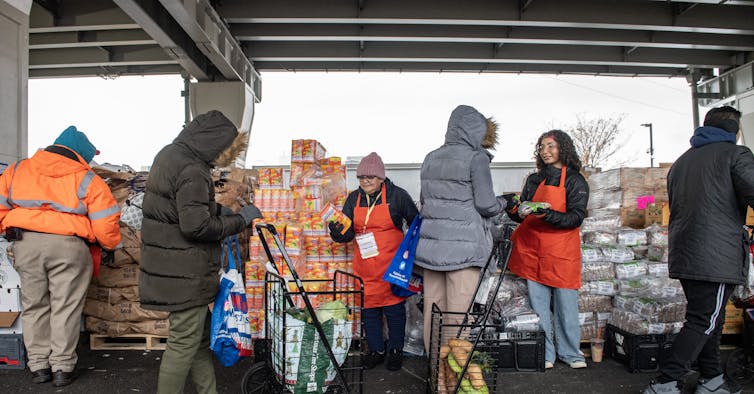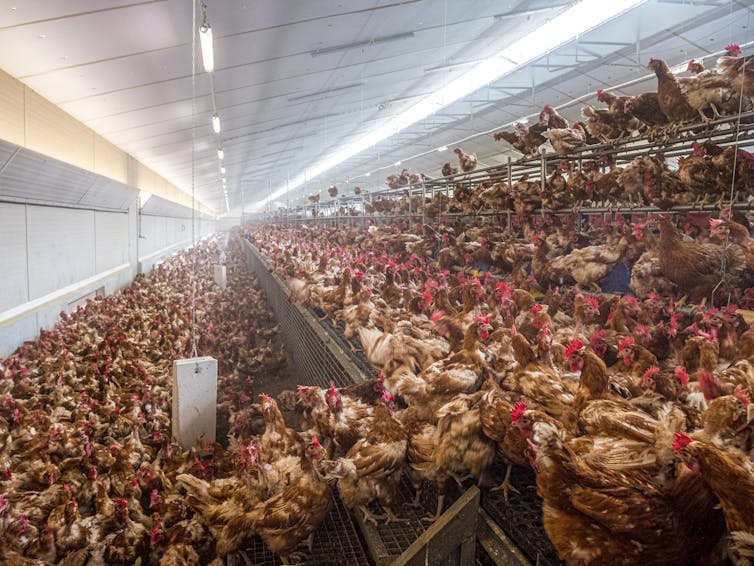
Joseph Prezioso/AFP via Getty Images
Dyana Mason, University of Oregon and Mirae Kim, George Mason University
On Jan. 27, 2025, the Trump administration ordered a freeze on federal grants and contracts covering a wide array of aid programs to take effect at . This freeze was partially prevented when a judge responded to a lawsuit filed by the National Council of Nonprofits and other organizations. The flow of funds on grants that had already been awarded was at least temporarily protected by the judge’s action. The attorneys general of 22 states and the District of Columbia have also sued to block this funding freeze.
The Trump administration, which on Jan. 29 rescinded the memo ordering the funding suspension, has made clear that it may again seek to reduce or eliminate much of the money, totaling several hundred billion dollars, that funds many services that nonprofits provide, such as support for foster parents, after-school care and distributing food for free.
Dyana Mason and Mirae Kim, two scholars of nonprofits, explain the role that federal funding plays in the nonprofit sector.
How much do nonprofits rely on federal funding?
Nonprofits partner with the government to deliver social services, such as child care for low-income families, housing for people experiencing homelessness, and job training and placement. These partnerships can form with local or state governments, as well as with the federal government, with this collaboration mostly taking place through grants and contracts.
Government funding makes up about 33% of the revenue flowing into the nonprofit sector annually, according to the Urban Institute. The institute, a think tank, also found that nearly 40% of all nonprofits in the United States applied for federal grants in 2021, 2022 and 2023, and that about 10% applied for federal contracts. The share of government funding can be far larger for some kinds of social service nonprofits.
Many other nonprofits applied for local and state grants during that three-year period. Those grants, however, are often themselves funded by the federal government indirectly through grants it makes to state and local government agencies. Those agencies, in turn, then provide grants or maintain contracts with local nonprofits to provide services.
Although it’s hard to track with absolute precision due to those complex arrangements, government revenue is the second-largest source of income for nonprofits after the money these organizations and institutions earn through commercial activities.
Also called “fee-for-service,” this revenue includes the money nonprofit hospitals get when patients and insurers pay medical bills, nonprofit theaters receive when they sell tickets to performances, and nonprofit private schools obtain when parents pay tuition.
Some social service nonprofits charge fees too, typically on a sliding scale. That is, their clients with relatively higher incomes pay more, and those with extremely low incomes pay very little or nothing at all.
How could freezing federal funding affect nonprofits?
We have no doubt that a long freeze on federal grants and contracts would be devastating for nonprofits and the communities they serve.
For example, Meals on Wheels, a program that delivers hot meals to more than 2 million homebound people over 65 and helps them maintain social connections, gets 37% of its funding from the federal government.
Clackamas Women’s Services, a domestic and sexual violence organization based near Portland, Oregon, is one of the many local organizations that have expressed concern about what to expect. The group says it could lose half of its annual budget if federal funding were to be eliminated.
Without federal funding, organizations like these – many of which already have waitlists – would have to cut back on the services they provide.
What’s the role of nonprofits in the US safety net?
It’s very significant.
For the past several decades, attempts to scale back the size of the government have led to government agencies essentially hiring nonprofits to do much of their work.
Through contracts and grants, nonprofits then do such things as assist people who are recovering from fires, hurricanes and other disasters; provide services for veterans and active-duty members of the military; and help people with mental health conditions, including substance use problems, just to name a few.
This arrangement typically provides nonprofits with a reliable and predictable source of funds that they can use to serve their communities. But it can also leave them vulnerable to policy changes – especially when new administrations take over, as the second Trump administration’s actions illustrate.
Research we conducted about what happened to nonprofits during the COVID-19 pandemic showed that volatility in the economy has serious effects on the ability of nonprofits to do their work.
For example, social service nonprofits struggled in March and April 2020 due to falling revenue at a time of increasing demand. Many of these organizations had to scale back their services. In some cases, they canceled them.
We followed up with another survey in November and December 2020. By then, we found, 61% of the groups had received forgivable federal loans through the government’s Paycheck Protection Program.
Nearly half of the nonprofits told us that they had, in addition, received other forms of emergency funding from the federal government, including Economic Injury Disaster Loans and emergency food distributions.
This federal assistance made it possible for thousands of nonprofits to keep their staff employed and continue to provide important services as the economy recovered.
What happens when nonprofits lose federal funds?
It’s hard for social service organizations to replace federal funding.
Nonprofits can, of course, appeal to their donors to help bridge the gap. But donations from individuals, foundations, corporations and bequests only amount to no more than 15% of the funds flowing into the nonprofit sector.
The outcome of freezing, eliminating or scaling back federal funding for nonprofits would mean that those in need would get fewer services. We would also expect mass layoffs, which could harm the U.S. economy.
Nonprofits employ more than 12 million people in the United States. That’s more workers than big industries such as construction, transportation and finance employ. Should millions of them suddenly become unemployed, demand would grow further for social services from providers already unable to meet lower levels of demand due to funding cuts.
Has there ever been upheaval like this before?
Congress appropriates money to provide for the services that the public needs and demands. These moves have led to great fear and uncertainty among organizations that serve people in need in the United States and abroad.
Although it’s not unusual for funding priorities to change from one administration to the next, Donald Trump’s executive orders on international aid and nonprofit grants and contracts that underpin the U.S. safety net are unprecedented.
Dyana Mason, Associate Professor of Planning, Public Policy and Management, University of Oregon and Mirae Kim, Associate Professor of Nonprofit Studies, George Mason University
This article is republished from The Conversation under a Creative Commons license. Read the original article.





























































